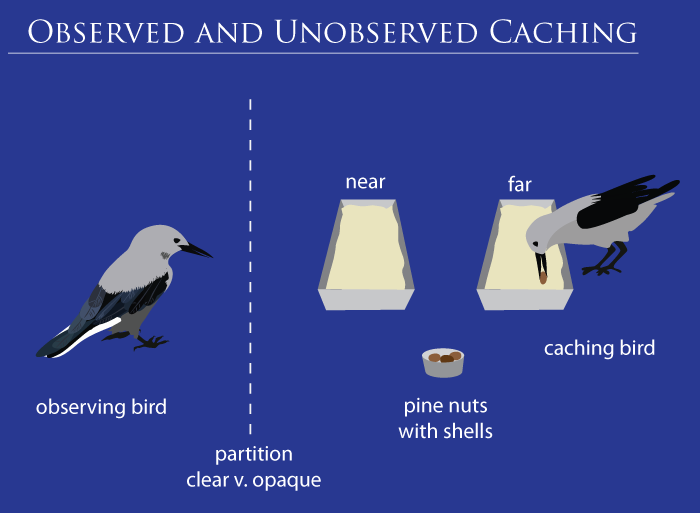|
|
How does intelligence arise? A graduate researcher seeks evidence from birds.
Do birds of a feather that flock together develop more complex cognitive behaviors than solitary birds? Or do other factors such as foraging pressure drive the development of cognitive behaviors as well? Psychology graduate student Jan Tornick’s research seeks to answer those questions.
“I’ve always been interested in animal behavior,” Tornick says, noting that she was one of those kids who would bring home bugs and snakes and mice, much to her mother’s dismay. “I am curious about how animals think and how their world compares to ours.”
For the past five years, Tornick has studied Clark’s nutcrackers under the supervision of her adviser Brett Gibson, associate professor of psychology. Tornick’s research compares Clark’s nutcrackers to other species, most notably, western scrub jays. Both species are in the crow family, but the Clark’s nutcracker is characterized as asocial while the western scrub jay, like most birds in the crow family, is very social.

Evolutionary psychologists think that the demands of living in a large dynamic social group might drive a species’ need for complex cognitive behavior. “This ‘social intelligence hypothesis’ provides one possible explanation of why humans have become so intelligent, says Tornick. “My research on Clark’s nutcrackers explores if sociality or if other demands like foraging, drive the need for complex cognition.”
A landmark study showed that scrub jays take a lot of precautions with their food. When another scrub jay is watching, a scrub jay will store food in difficult to see places (far from an observer, behind a visual barrier, etc.). Often, if observed while hiding food, later, when unobserved, a scrub jay will move food to another location. This “social caching” experiment supports the social intelligence hypothesis.
To compare the two species, Tornick replicated the “social caching” experiment with the Clark’s nutcrackers. Known for their spatial memories, nutcrackers hide up to 30,000 seeds, and they find 90 percent of them in order to survive long winters high up in the Rockies.
But why is it so important to study a bird in the crow family? In recent years, crows and their relatives have demonstrated astonishing cognitive skills; in many cases these are on par with those of apes and young human children. For example, it has been well documented that a related bird, the New Caledonian crow, manufactures, transports, and utilizes specialized tools. As Tornick explains in her dissertation proposal: “Darwin noted that there is evolutionary continuity among different species; and cognitive variations among different species are ‘differences in degree rather than differences in kind.’ To shed light on the differences and similarities between the human and the non-human mind, it is important to study a wide variety of species.”
Her initial findings on social caching for Clark’s nutcrackers suggests that the nutcrackers (like scrub jays) do tend to alter their behavior when observed hiding their food by another bird but not when they are alone. Tornick notes this suggests that group size may not be the sole force driving the evolution of social intelligence. She thinks that other factors, such as foraging strategy or genetic relatedness, might also be important.
|
Jan Tornick’ s Clark’s nutcracker experiment explored the subject’s caching behaviors under different conditions. These conditions included the subject being observed or not observed by another bird, partitions, distance of the caching trays, and varied light. |
|
Jan Tornick |
In addition to social intelligence, Tornick’s dissertation research on Clark’s nutcrackers examines two other areas of cognition: reasoning ability and numerical intelligence.
Tornick is currently testing Clark’s nutcrackers for numerical cognition to see if they have developed enhanced competence as compared to more social birds in the crow family (and other animals). Since numerical competence is thought to reside in the same part of the brain as spatial memory, Tornick thought the nutcrackers might excel at number discrimination. This would suggest that foraging pressures were a factor in developing cognitive intelligence.
Her initial findings indicate that Clark’s nutcrackers are very good at distinguishing between different quantities of seeds. Given two piles of seeds to choose from, they almost always choose the larger, even when the quantities are close.
Tornick is in the process of concluding her research and writing her dissertation. A first-generation college student, Tornick has succeeded at academics from her first associate in applied science degree in architectural design to her graduate studies at UNH. Initially interested in zoology, she earned her master’s degree in 2007. Then, to pursue her interest in cognitive behavior, she earned a second master’s degree, this time in psychology, and now she has almost completed her doctoral studies.
Tornick’s work with Clark’s nutcrackers inspires both wonder and enthusiasm. “Their spatial memory is amazing,” she says. “I want to discover what else they might know.”
Originally published by:
UNH Today
Words by Carrie Sherman, Editorial and Creative Services. Illustrations by Bridget Finnegan, New and Emerging Media. Photo of Jan Tornick by Lisa Nugent, UNH Photographic Services.



















































 Watch videos of Tornick's experiments.
Watch videos of Tornick's experiments.


